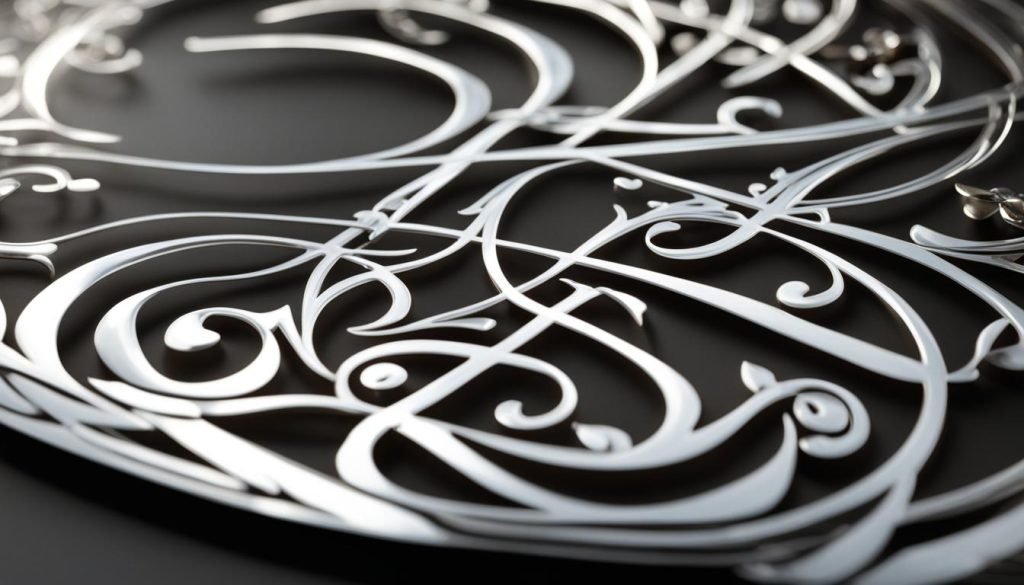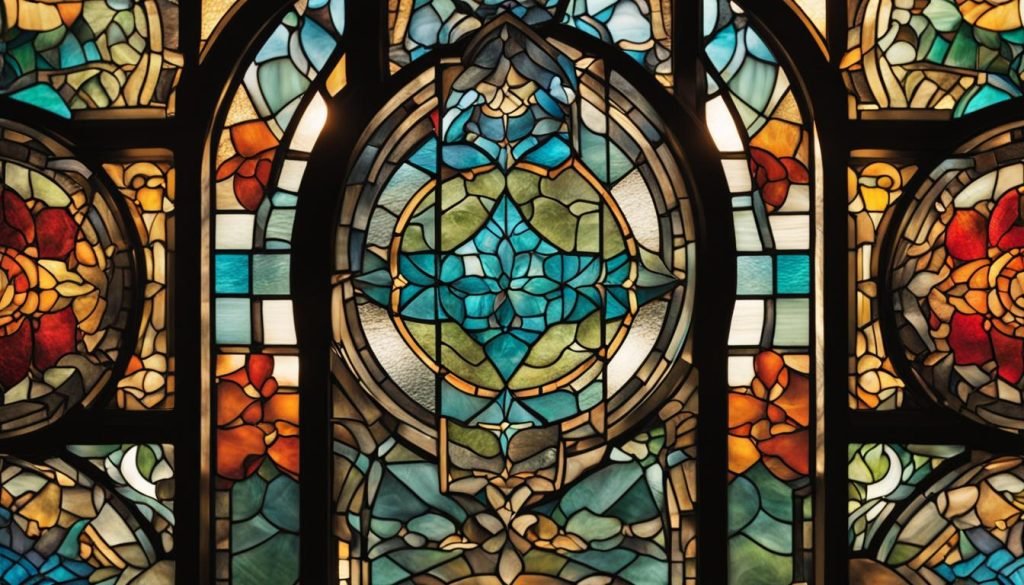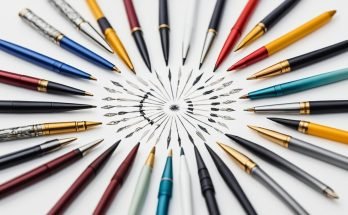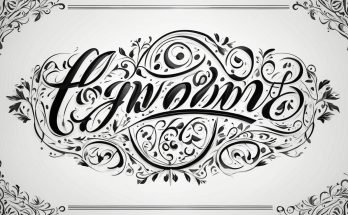Calligraphy on Glass: Discover the Mesmerizing Art of See-Through Beauty
Welcome to the enchanting world of calligraphy on glass, where tradition meets innovation to create stunning visual masterpieces. Whether it’s engraving, lettering, or custom designs, this timeless art form adds a touch of elegance and beauty to glass surfaces. With its transparent allure, calligraphy on glass is sure to captivate and impress.
Key Takeaways:
- Calligraphy on glass combines tradition and innovation to create visually captivating pieces.
- Glass pens are delicate tools that allow for precise and intricate writing on glass.
- Arabic calligraphy on glass showcases the beauty and emotion of the language.
- Fusion of Arabic calligraphy and stained glass art represents a harmonious blend of tradition and innovation.
- The Seven Pillars of Humanity art installation symbolizes unity and diversity.
The Delicate Beauty of Glass Pens
Glass pens are a unique and exquisite tool for creating stunning calligraphy on glass surfaces. Inspired by the elegance of 16th-century Venice, these delicate pens feature shimmering glass handles and fine tips that hold the ink with precision. Their delicate nature allows for intricate designs and lettering, adding a touch of beauty and sophistication to any glass artwork.
Using a glass pen is a delightful experience, as it glides smoothly across the glass surface, leaving behind a trail of ink that appears almost magical. The transparency of glass combined with the fluidity of the ink creates a mesmerizing effect, enhancing the overall aesthetic of the calligraphy. Whether you’re creating personalized gifts, elegant home decor, or decorative glass art, a glass pen is the perfect tool to bring your vision to life.
Unlike traditional pens, glass pens are easy to clean and maintain. Simply rinse the pen with water to remove any residual ink and gently wipe it dry. With proper care, your glass pen will continue to provide you with countless hours of creative expression and beautiful calligraphy on glass.
Table: Glass Pen vs. Traditional Pen
| Glass Pen | Traditional Pen | |
|---|---|---|
| Material | Glass with a metal nib | Metal or plastic |
| Ease of Use | Requires a delicate touch | Suitable for various writing styles |
| Ink Flow | Smooth and consistent | Depends on the pen’s condition and ink quality |
| Cleaning | Easy to clean with water | May require disassembly and cleaning |
| Versatility | Ideal for glass surfaces | Suitable for different types of paper |
The Artistry of Arabic Calligraphy on Glass

Arabic calligraphy is a cherished art form that holds a significant place in Islamic culture and tradition. With its rich history and intricate designs, Arabic calligraphy is admired for its ability to convey the beauty and emotion of the Arabic language. When combined with the transparency of glass, this art form takes on a whole new dimension, creating captivating visual experiences.
Artists like Ali Albaddah from Kuwait have been pushing the boundaries of Arabic calligraphy by merging it with stained glass art. By incorporating Arabic calligraphy into stained glass pieces, they create breathtaking and meaningful creations that reflect the unity of religion, art, and architecture.
“Arabic calligraphy on glass offers a unique and captivating way to express the beauty of the Arabic language and Islamic art,” says Ali Albaddah.
Through his work, Ali Albaddah showcases the fusion of tradition and innovation, paying homage to the centuries-old art of Arabic calligraphy while adding a modern twist. His stained glass installations bring together the elegance and power of calligraphy with the versatility and beauty of glass, resulting in mesmerizing pieces that captivate viewers.
The Captivating Creations of Ali Albaddah
| Stained Glass Piece | Description |
|---|---|
| Arabic calligraphy intricately woven into a stained glass window, creating a breathtaking display of colors and craftsmanship. | |
| A stained glass panel featuring a verse from the Quran, showcasing the elegance and spirituality of Arabic calligraphy. | |
| Arabic calligraphy combined with floral motifs in a stained glass artwork, representing the harmony between nature and spirituality. |
The artistry of Arabic calligraphy on glass is a testament to the beauty of Islamic art and the creativity of artists like Ali Albaddah. It serves as a visual reminder of the rich cultural heritage and the deep-rooted traditions that continue to inspire and captivate people around the world.
The Fusion of Tradition and Innovation

Stained glass art has a rich history dating back centuries, known for its vibrant colors and intricate designs. In recent years, artists have been pushing the boundaries of this traditional art form by merging it with other artistic techniques. One remarkable fusion is the combination of stained glass with Arabic calligraphy.
Arabic calligraphy, with its flowing lines and expressive strokes, is a revered art form in Islamic culture. When applied to stained glass, it brings a new dimension of beauty and meaning. Artists like Ali Albaddah and the team at Holdman Studios are at the forefront of this innovative fusion, creating mesmerizing pieces that blend the elegance of calligraphy with the versatility of stained glass.
This fusion of tradition and innovation offers a unique visual experience. The bold strokes and intricate patterns of Arabic calligraphy come to life in the vibrant colors and translucent properties of stained glass. The interplay between light and glass adds depth and texture to the calligraphic art, captivating the viewer and evoking a sense of wonder.
| Traditional Art Forms | Modern Art Techniques |
|---|---|
| Stained glass | Arabic calligraphy |
| Mosaic | Stained glass techniques |
| Glass painting | Contemporary designs |
“The fusion of Arabic calligraphy and stained glass art represents a harmonious blend of tradition and innovation.”
The fusion of Arabic calligraphy and stained glass not only creates stunning works of art but also reflects the unity of religion, art, and architecture. These masterpieces serve as a testament to the power of artistic expression in bridging cultural divides and fostering appreciation for different traditions.
Exploring the Beauty of Arabic Calligraphy and Stained Glass
Arabic calligraphy and stained glass art are two distinct art forms that come together in a harmonious union. The intricate details of calligraphy enhance the inherent beauty of stained glass, bringing depth, meaning, and cultural significance to each piece.
Whether it’s a small decorative item or a large-scale installation, the fusion of tradition and innovation in Arabic calligraphy and stained glass creates visually stunning and emotionally captivating works of art. It is a testament to the boundless possibilities of artistic expression and the power of creativity to transcend cultural boundaries.
The Seven Pillars of Humanity: A Symbol of Unity
The Seven Pillars of Humanity is an extraordinary stained glass installation that embodies the concept of unity through symbolic art. Created by renowned artist Ali Albaddah in collaboration with Holdman Studios, this stunning masterpiece aims to break down barriers and foster understanding among diverse cultures and faiths.
Featuring intricate stained glass panels, each depicting motifs and symbols inspired by different cultures and beliefs, this installation serves as a powerful reminder of our shared humanity. The seven pillars represent key values such as love, compassion, empathy, and justice, which transcend cultural and religious boundaries.
As you gaze upon the vibrant colors and delicate craftsmanship of the Seven Pillars of Humanity, you are invited to reflect on the beauty of diversity and the importance of unity. This installation serves as a space of contemplation and connection, where people from all walks of life can find common ground and appreciate the richness of our collective heritage.
| Pillar | Symbol | Cultural Influence |
|---|---|---|
| Love | Heart | Universal |
| Compassion | Lotus Flower | Buddhism |
| Empathy | Hands | Various |
| Justice | Scales | Legal Systems |
| Wisdom | Owl | Western Philosophy |
| Harmony | Yin and Yang | Taoism |
| Unity | World Map | Global |
“The Seven Pillars of Humanity seeks to bridge cultures, connect people, and remind us of our shared values as human beings.” – Ali Albaddah
Getting Started with Glass Pens: Tips and Techniques
Using a glass pen may seem intimidating at first, but with the right techniques and care, it can be a rewarding and enjoyable experience. Whether you’re new to calligraphy or a seasoned enthusiast, here are some tips to help you get started with glass pens:
Choosing the Right Glass Pen
The first step in getting started with a glass pen is to choose the right one for your needs. Glass pens come in various shapes and sizes, each offering a unique writing experience. Some pens have a fine tip for intricate designs, while others have a broader tip for bolder lettering. Consider the type of calligraphy you want to create and choose a pen that suits your style.
Hold the Pen at the Right Angle
When using a glass pen, it’s important to hold it at the right angle to ensure smooth ink flow. The ideal angle typically ranges from 30 to 45 degrees, but it may vary depending on the pen and your personal preference. Experiment with different angles to find what works best for you.
Using the Correct Ink
Choosing the right ink is crucial for optimal performance with a glass pen. Fountain pen ink, calligraphy ink, Ecoline liquid watercolor, and India ink are all suitable options. These inks flow smoothly through the delicate grooves of the pen, ensuring consistent and vibrant lines. Avoid using thicker inks or acrylic paints, as they may clog the pen or cause uneven ink flow.
| Glass Pen Techniques and Tips | Glass Pen Care |
|---|---|
|
|
With these tips and techniques, you’re ready to embark on your calligraphy journey with a glass pen. Remember to practice, experiment, and have fun as you explore the beautiful art of writing on glass.
Choosing the Right Ink for Glass Pens
When it comes to using a glass pen for calligraphy on glass surfaces, selecting the right ink is crucial. The type of ink you choose will determine the flow, vibrancy, and overall performance of your glass pen. Here are some popular ink options that work well with glass pens:
Fountain Pen Ink
Fountain pen ink is a versatile choice for glass pens due to its smooth flow and wide range of colors. It is available in both water-based and waterproof formulations, allowing you to achieve different effects. Keep in mind that certain fountain pen inks may require longer drying times on glass, so it’s important to test them beforehand.
Calligraphy Ink
Specifically formulated for calligraphy, this type of ink is often preferred by calligraphers for its rich pigmentation and easy flow. Calligraphy ink is available in various colors and finishes, allowing you to create stunning designs on glass surfaces. It is important to choose an ink that is compatible with glass and does not smudge or fade easily.
Ecoline Liquid Watercolor
Ecoline liquid watercolors are highly pigmented and offer vibrant colors that are perfect for glass pen calligraphy. These watercolors are transparent and blend beautifully on glass surfaces, creating stunning gradients and effects. They are water-based and dry quickly, making them a popular choice for both beginners and experienced artists.
India Ink
India ink is a classic choice for glass pen calligraphy due to its intense black color and waterproof properties. It flows smoothly through the pen and provides sharp, crisp lines on the glass surface. India ink is also available in different colors, allowing you to experiment and create unique designs. Keep in mind that India ink can dry quickly, so it’s essential to clean your glass pen promptly after use.
| Ink Type | Advantages | Considerations |
|---|---|---|
| Fountain Pen Ink | Smooth flow, wide color range | May require longer drying times |
| Calligraphy Ink | Rich pigmentation, easy flow | Ensure compatibility with glass |
| Ecoline Liquid Watercolor | Highly pigmented, vibrant colors | Water-based, may blend easily |
| India Ink | Intense black color, waterproof | Dries quickly, prompt cleaning required |
When selecting ink for your glass pen, it’s important to consider the specific requirements of your project and personal preferences. Experimenting with different inks will allow you to discover the ones that work best for your creative vision and desired effects. Remember to follow the manufacturer’s instructions for each ink type and properly clean your glass pen after each use to maintain its performance.
Caring for Your Glass Pen: Cleaning and Storage Tips
Proper care and maintenance of your glass pen are essential for ensuring its longevity and continued performance. By following these cleaning and storage tips, you can keep your glass pen in excellent condition for years to come.
Cleaning Your Glass Pen
When it comes to cleaning your glass pen, simplicity is key. Start by rinsing the pen nib with warm water to remove any residual ink. Use a soft cloth or paper towel to gently wipe the nib, ensuring that all traces of ink are gone. Avoid using harsh chemicals or abrasive materials, as these can damage the delicate glass. If you prefer, you can also use a mild soap solution for a more thorough cleaning.
“Proper care and maintenance of your glass pen are essential for ensuring its longevity and continued performance.”
Storage Tips for Your Glass Pen
When it comes to storing your glass pen, it’s important to protect it from potential damage. Store your pen in its original box or a designated case specifically designed for glass pens. This will help prevent the pen from getting scratched or chipped. Additionally, avoid placing heavy objects on top of your pen, as this can lead to breakage. Finally, it’s best to store your glass pen in a cool and dry place, away from direct sunlight and extreme temperatures.
Maintaining Your Glass Pen
Regular maintenance is key to keeping your glass pen in optimal condition. Here are a few additional tips to help you maintain your pen:
- Always cap your pen when not in use to prevent the nib from drying out.
- Avoid dropping your glass pen, as this can cause the delicate glass to break.
- Do not share your glass pen with others, as everyone’s writing pressure and habits are different, which can affect the pen’s performance.
- If you notice any issues with your pen, such as ink flow problems or a loose nib, it may be time to replace the nib or consult a professional.
By following these cleaning and storage tips, as well as maintaining your glass pen properly, you can ensure that it remains in excellent condition for years to come, providing you with countless hours of creative expression.
Conclusion
After exploring the world of calligraphy on glass, it’s clear that this art form offers a unique and visually captivating way to express your creativity. By using a glass pen, you can create intricate designs and lettering that truly stand out on glass surfaces. The delicate beauty of glass pens, inspired by 16th-century Venice, allows for precise and elegant writing.
Arabic calligraphy on glass takes this art form to another level, merging tradition and innovation. Artists like Ali Albaddah have pushed the boundaries by combining the beauty of Arabic calligraphy with the versatility of stained glass art, resulting in mesmerizing pieces that reflect the unity of religion, art, and architecture.
Whether you’re a calligraphy enthusiast or someone looking to try something new, calligraphy on glass with a glass pen is a rewarding experience. So, don’t hesitate to let your creativity flow and explore the beauty of calligraphy on glass. It’s a journey of artistry and self-expression that is sure to leave you inspired.
FAQ
What is calligraphy on glass?
Calligraphy on glass is a timeless art form that combines tradition and innovation to create stunning visual effects on glass surfaces. It can be done through techniques such as engraving, lettering, and custom designs.
Why are glass pens ideal for calligraphy on glass?
Glass pens are perfect for calligraphy on glass because they offer a delicate and precise writing experience. Inspired by 16th-century Venice, these pens feature fine tips and shimmering glass handles that hold the ink, allowing for intricate designs and lettering.
What role does Arabic calligraphy play in calligraphy on glass?
Arabic calligraphy holds a special place in the Islamic art and cultural tradition. When combined with the transparency of glass, it creates a unique and captivating visual experience. Artists like Ali Albaddah have merged Arabic calligraphy with stained glass art to create breathtaking and meaningful creations.
How does the fusion of Arabic calligraphy and stained glass art work?
The fusion of Arabic calligraphy and stained glass art represents a harmonious blend of tradition and innovation. Artists like Ali Albaddah and the team at Holdman Studios push the boundaries of both art forms to create mesmerizing pieces that reflect the unity of religion, art, and architecture.
What is The Seven Pillars of Humanity art installation?
The Seven Pillars of Humanity is an art installation being created by Ali Albaddah and the team at Holdman Studios. It symbolizes unity and breaks down walls between cultures and faiths. The installation consists of intricate stained glass panels with motifs and symbols inspired by different cultures and beliefs.
Are glass pens easy to use?
Yes, glass pens are easy to use. With the right techniques and care, they can provide a rewarding and enjoyable experience. Holding the pen at the right angle, using the correct ink, and choosing the right paper are essential for a smooth writing or drawing experience.
What type of ink is suitable for glass pens?
Various types of ink are suitable for glass pens, including fountain pen ink, calligraphy ink, Ecoline liquid watercolor, and India ink. These inks flow smoothly through the delicate grooves of the pen and provide vibrant colors.
How should I care for my glass pen?
Proper care and maintenance of your glass pen are essential for its longevity. Cleaning the pen regularly with water and a paper towel removes residual ink, and storing the pen in its original box or a designated case helps protect it from damage.
What is the appeal of calligraphy on glass with a glass pen?
Calligraphy on glass with a glass pen offers a unique and visually captivating way to express creativity. With the combination of traditional calligraphy techniques and the innovation of glass art, artists like Ali Albaddah are pushing the boundaries of this art form.




